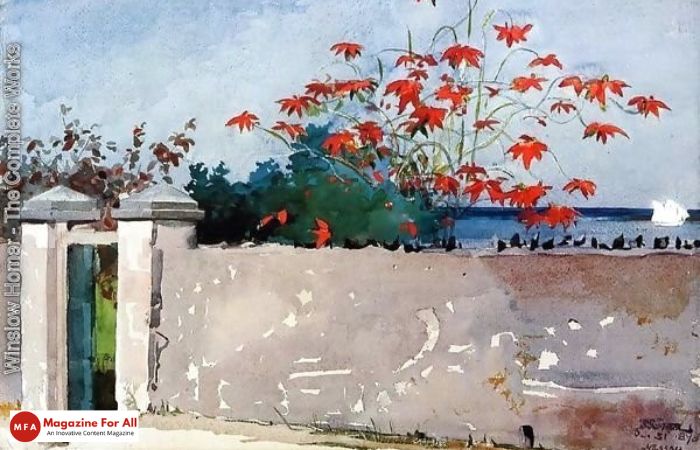Table of Contents
From Crisis to Canvas: Tracing Winslow Homer’s Artistic Evolution Amidst Hardship
Winslow Homer, one of America’s most celebrated artists, experienced a tumultuous journey that shaped his artistic evolution. Amidst the trials and tribulations he faced, Homer’s resilience and determination not only propelled him forward but also influenced the course of American art.
Born in 1836 in Boston, Massachusetts, Homer began his artistic pursuits as an apprentice at a lithography studio. However, his aspirations to become a painter soon led him to study at the National Academy of Design in New York City. It was during this time that Homer’s career took an unexpected turn as the nation plunged into a period of crisis—the American Civil War.
The war proved to be a pivotal moment in Homer’s life. As a young man, he served as a freelance illustrator, capturing the reality of the conflict through his sketches. These experiences on the front lines shaped his perspective, providing him with a firsthand understanding of the human struggle and the profound impact it would have on his artistic expression.
Homer’s artistic evolution can be seen through his transition from illustration to painting. His early works reflected the horrors of war, depicting scenes of wounded soldiers, battlefields, and the emotional toll on the individuals involved. These poignant portrayals captured the attention of both critics and art enthusiasts, showcasing Homer’s ability to evoke empathy and capture the raw essence of human experience.
As the war ended, Winslow Homer‘s focus shifted towards capturing the everyday lives of ordinary Americans. He turned his attention to scenes of rural life, coastal landscapes, and the interplay of light and shadow. Through his masterful use of color and composition, he transported viewers into serene moments, providing a sense of respite from the harsh realities of the time.
Despite the personal and professional challenges Homer faced, he persisted in his artistic pursuits. He continued to experiment with different mediums, including watercolors and oil paints, further expanding his repertoire. His dedication to his craft allowed him to create a body of work that not only documented the social and political climate of his era but also resonated with viewers on a deeply emotional level.
Today, Winslow Homer’s artistic evolution amidst hardship serves as a testament to the power of resilience and the transformative nature of art. His ability to channel his experiences into powerful visual narratives continues to inspire generations of artists and art enthusiasts alike. Through his work, we can trace the trajectory of a man who transformed crisis into canvas, leaving behind an indelible mark on American art history.
Mastering the Art of Resilience: Uncovering the Inner Strength of Winslow Homer’s Hard Times

Winslow Homer, a renowned artist of the 19th century, faced numerous challenges and hardships throughout his life. However, it was through these trials that he discovered and harnessed his inner strength, showcasing remarkable resilience that would shape his artistic journey and leave an enduring legacy.
Born in 1836 in Boston, Homer embarked on his artistic pursuits with great enthusiasm. He trained as an apprentice at a lithography studio before venturing into the world of painting. Despite his early successes as an illustrator, Homer encountered setbacks and rejection, which tested his resolve. It was during these difficult times that he tapped into a wellspring of resilience, refusing to let adversity dampen his creative spirit.
One of the defining moments in Homer’s life was the American Civil War. Witnessing the brutality and devastation firsthand as a freelance illustrator, he confronted the harsh realities of human suffering. However, instead of succumbing to despair, Homer channeled these experiences into his work, employing his artistic talents to capture the raw emotions and realities of war. This period of intense turmoil became a catalyst for his growth as an artist, as he explored the depths of human resilience and fortitude.
Homer’s artistic style evolved alongside his personal resilience. As he ventured beyond the realm of illustration and delved into painting, he developed a distinctive approach characterized by powerful narratives and emotive brushwork. Through his paintings, he depicted scenes of fishermen battling treacherous waves, farmers toiling in the fields, and individuals confronting the elements of nature. These works reflected not only the physical strength required to endure but also the mental and emotional resilience necessary to persevere in the face of adversity.
Moreover, Homer’s choice of subject matter extended beyond the external struggles of everyday life. He delved into the internal landscapes of his subjects, exploring the complexities of human emotions and the indomitable spirit that lies within. Whether depicting a solitary figure contemplating the vastness of the sea or capturing the determination etched on the face of a weary laborer, Homer’s paintings revealed the resilience that resides deep within the human soul.
The enduring legacy of Winslow Homer lies not only in his artistic achievements but also in the inspiration he provides to individuals facing their own hardships. His ability to transform personal struggles into works of art serves as a testament to the power of resilience and the triumph of the human spirit. Homer’s journey reminds us that even in the darkest of times, there is strength to be found, and through art, we can transcend our circumstances and leave a lasting impact on the world.
In uncovering the inner strength of Winslow Homer’s hard times, we gain a deeper appreciation for the transformative power of resilience and the enduring beauty that can emerge from even the most challenging of life’s circumstances.
Conclusion
Wislow Homer’s unyielding journey through hard times, as explored in this article, reveals a remarkable story of resilience, determination, and artistic growth. From his early experiences as a Civil War illustrator to his transition into painting, Homer confronted adversity head-on and transformed it into a source of inspiration.
Through his art, Homer captured the raw emotions, struggles, and triumphs of individuals navigating through challenging circumstances. His ability to convey the human experience, both external and internal, with such profound depth is a testament to his keen observation and unwavering commitment to his craft.
Homer’s evolution as an artist paralleled his personal resilience. His exploration of different mediums, subject matters, and techniques showcased his adaptability and willingness to embrace new challenges. It is through these artistic experiments that he was able to create a body of work that not only reflected the social and historical context of his time but also transcended it, resonating with viewers across generations.
Today, Winslow Homer’s legacy serves as a beacon of inspiration for artists and individuals alike. His journey reminds us that even in the face of hardship, there is beauty, strength, and an opportunity for growth. By channeling his own experiences of adversity into his art, Homer demonstrated the transformative power of creativity, offering solace, reflection, and hope to those who encounter his works.
Ink and adversity may seem like unlikely companions, but for Winslow Homer, they were integral to his artistic journey. Through his unyielding spirit, he transformed crises into canvases, leaving behind a profound artistic legacy that continues to captivate and inspire. As we explore the depths of his work and delve into the stories they tell, we are reminded of the extraordinary resilience that lies within us all, waiting to be discovered and harnessed.










































































